Lately, I have been obsessed with buying Mamianqun (Horse faced skirts). It’s part of my growing fascination with hanfu — traditional Chinese clothing. While I have bought a few modernised Tang and Song dynasty outfits, the first piece of hanfu I bought was a mamianqun and the pieces I’m most often drawn to are mamianqun.
While the mamianqun has its roots in the Song dynasty, it’s a piece of hanfu most commonly associated with the Ming dynasty. It consists of two overlapping pieces of fabric and when you wear it, you’ll see one front panel and with pleats on both sides. To be frank, there are tons of details in the skirts that I don’t fully get – Chinese posts on the subject talk about the number of pleats, the cutting, how the skirt can make you look fat or slim, and so on. All I really know is that there are so many beautiful skirt patterns that it’s difficult not to keep on buying them.
Patterns aside, I also love how easy it is to integrate the mamianqun into an outfit. While uniquely Chinese in its construction, the mamianqun can be paired with Western clothing fairly easily. So when I was packing my luggage for Okinawa, I packed a mamianqun as well. Well, I didn’t just pack a mamianqun, I also convinced another friend to borrow two of my skirts to try.
Since the skirt I packed was a beautiful navy blue, I decided to wear it for our day at the Ocean Expo Park, where we would be visiting Churaumi Aquarium. Churaumi Aquarium is located near the ocean and naturally, we took photos on one of the small beaches.

That turned out to be the perfect yet awkward spot to wear mamianqun. Awkward because while the mamianqun can be very useful for going to the bathroom while travelling, it’s also prone to exposing everything during a strong gust of wind thanks to its construction. The two pieces of fabric overlap, which means that they aren’t sewn together and can be blown apart. I have to admit that I spent quite a bit of time just holding my skirt together when we were walking from one spot to another. After this incident (since two of us were wearing mamianqun), I looked up this problem and am going to try using hairpins to pin the two larger panels together.
Wind issues aside, the mannequin was perfect because of the history of Okinawa. As it turned out, during the Ming dynasty when Emperor Hongwu ascended to the throne, he made several significant changes. One of them was to ban sea travel, and the other was to establish a regional tributary system. Before this, the term 琉球 [ch. Liuqiu, j. Ryukyu] was applied to a large region that included the Okinawan islands and Taiwan. However, as Emperor Hongwu was building vassal relationships with various states, the emperor of Chuzan in Okinawa sent his brother as a tribute envoy, thus bringing Okinawa into the tribute system.
That changed everything.
Because private commerce was now banned, people traded by using space on tribute ships to carry supplementary cargo. In other words, tribute ships became trade ships. And the Ryukyu Kingdom became so favoured that we see not only maps labelling the Okinawan islands as 琉球国 or Land of Ryukyu, we even see a ‘downgrade’ in the islands of Taiwan as Zhen Ruoceng, a Ming-era geographer, labelled Taiwan as “Little Liuqiu (Ryukyu)” on a map, despite Taiwan being geographically much larger!
Another mark of favour was shown by the fact that while other countries had limits on how frequently it could pay tribute, the Ryukyu kingdom had no specific legation schedule, meaning it could travel to China as many times as they wanted. According to Akiyama Kenzo’s research, this resulted in 171 legations from Ryukyu to the Ming court, while in the same time period, the next two countries with the most frequent legations were Annam (Vietnam) with 89 legations and Tibet with 78 legations. This meant that the Ryukyu kingdom became a center for trade within the region as it could carry goods using its tribute ships and this formed a central part of its identity; the Bridge of Nations Bell (bankoku shinryo no kane; lit the bell of 10,000 nations) in Shuri castle has the Ryukyu people define themselves as “a bridge between the many various countries.”
Coincidentally, that was what I told my interviewers when I was trying to get my scholarship. Well, I said something like that. “I want to build bridges between Japan and Singapore”, words that were perhaps said by every scholarship recipient. But the sentiment was true; one of the things I most appreciated about my time in Japan was the lack of an ‘expat bubble’. As it turns out, having to take all your classes in Japanese instead of English means that you naturally mix with the Japanese students instead of staying with the other foreign students.
Honestly, that was so fun and I definitely treasure the friends that I made. One of them even came to Okinawa to visit me while I was there; we hadn’t seen each other since we graduated from university but as soon as I saw her, it felt like no time had passed. Our friendship has been subsisting from intermittent Line messages, mostly at Christmas and New Year’s, so this was a real feast for us both.
But back to the topic of building bridges. After I came back from Japan, I realised that I had perhaps immersed myself too deeply into Japanese culture. I owned a few sets of kimonos, but no hanfu or cheongsam. I could speak and write in Japanese, but I told everyone that I was horrible at Chinese. In short, I threw myself into a culture that I knew I would never fully belong to (and did not end up staying long-term) and lost touch with my own heritage. To make things more complicated, being Singaporean is different from being a Chinese citizen, even if my ethnicity is Chinese. I’ve always grown up speaking English instead of Chinese and I’ve never felt that connected to Chinese culture (probably why it was so easy to throw myself into learning about Japanese culture).
And so hanfu is my way of bridging the gap, that by not only learning about the history of this garment but also by incorporating it into my wardrobe, I slowly find a way to connect back with my Chinese cultural heritage without feeling like a poser or like I’m wearing a costume. Learning about Okinawa’s history and wearing mamianqun there brought an additional layer of hope, because if the Ryukyu kingdom can balance being a kingdom with close ties to China and Japan, then of course I can balance both my love for Japan, a country that has tattooed itself onto my heart and my desire to learn more about my Chinese heritage while still remaining my very English-speaking Singaporean self.
Note: I have described only the start of Okinawa’s delicate balance of relationships between Japan and China. For more information on the history of Okinawa, I have found the following book to be an invaluable resource (and where I got most of my information for this post):
Akamine, Mamoru. The Ryukyu Kingdom: Cornerstone of East Asia. University of Hawaii Press, 2016.
(I’ll post a review of this book tomorrow and you can tell me if you prefer the book review or if you prefer to just get some information via something like this)

Love that skirt and print and story related to it.
Thank you! The skirt is beautiful, I really like it!
The Mamianqun looks beautiful! I just wish you’d shown us the front of it (and you).
It’s so funny that the ban on trade did not actually succeed in banning trade, just rerouted it through tribute ships. Ain’t that just the way?
When people want goods from overseas, they will find a way to obtain them (reminds me of how tea was smuggled into England when the tax of them was very high!).